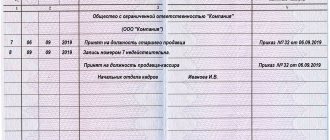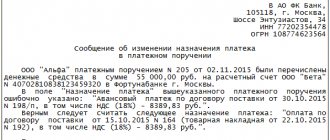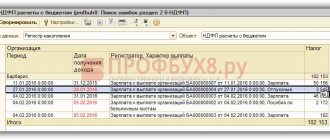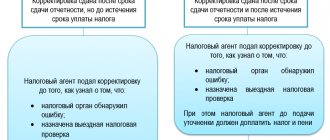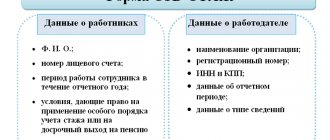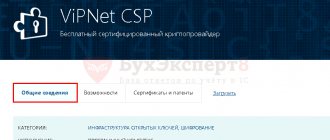General information
First of all, let’s define what individual personalized accounting is, when it became necessary to submit information about employees, accrued and paid insurance contributions to the Pension Fund in Russia, and what regulatory documents govern the procedure for compiling and submitting reports.
Basic definitions
In accordance with Law 27-FZ on individual personalized accounting in compulsory pension insurance, the expression “individual personalized accounting” means:
organizing and maintaining records of all insured persons individually in order to realize the pension rights of citizens of the Russian Federation.
The storage of the individual personal account of the insured persons is carried out throughout their entire life and after death until the moment specified in the procedure for storing the pension file.
After the death of a citizen, data on him according to the approved form will be transferred to the Pension Fund of Russia branch where the person was registered. All information is confidential.
The insured person is considered to be a person who has concluded an employment or civil legal contract with the employer and fulfills his obligations by carrying out activities to provide services and perform work.
This also applies to other citizens who have relations with pension insurance in accordance with document No. 167-FZ.
The policyholder is a company with the status of a legal entity or an individual entrepreneur that makes transfers to an individual.
Components of personalized accounting in the compulsory pension insurance system:
- registration of persons;
- collection of information about length of service, salary and profit, assessments of contributions and their payment;
- collection of data on the period of work or other type of activity before registration in the pension insurance system;
- sending the person the data contained in the individual personal account;
- adjustment of the pension amount.
Performed tasks and functions
This type of accounting is used to:
- to create conditions for assigning a pension according to the performance of each employee who is insured;
- to ensure the reliability of information about length of service and salary (or other income), which determine the amount of pension payments;
- to create an information base for the implementation and improvement of the laws of the Russian Federation, to assign labor pensions based on the length of service and the amount of contributions;
- to develop the interest of the insured person to pay insurance contributions to the Pension Fund of Russia;
- to create conditions for controlling the payment of funds by persons who are insured;
- to manage the administration of insurance premiums;
- to provide information support for forecasting the costs of transferring insurance pension payments, determine the contribution rate, calculate macroeconomic indicators regarding the pension type of insurance;
- to simplify the procedure and speed up the process of assigning a pension.
Principles of personalized accounting:
- Unity and federal nature of insurance.
- Universality and obligatory nature of transfers and recording of data on persons.
- Availability of your data to insured citizens.
- The information is used only for the purposes of pension insurance, etc.
What year did it start?
When did the personalized individual accounting report begin to be submitted? The practical implementation of the Pension Fund's activities in this area began on August 18, 1995.
Legal grounds
Regulatory acts that indicate from what year personalized records are kept and what is the procedure for its implementation:
- Law on personalized accounting, approved on April 1, 1996 No. 27-FZ.
- Regulatory document approved by the Russian authorities dated March 15, 1997 No. 318.
- The instructions are contained in document No. 987n of the Ministry of Health and Social Development dated December 14, 2009.
- Government Decree No. 192p dated July 31, 2006, which specifies the forms of documentation to be used.
Features of personalized reporting in 2019
Starting from 2021, reporting regarding the calculation of insurance premiums (including those intended for the Pension Fund of Russia) is submitted to the tax authorities. The calculation of contributions, which combines information on all types of contributions transferred under the control of the Federal Tax Service, contains a section devoted to personalized data. However, these data only include information on accrued income for the period and related contributions. There is no information about experience in them.
Read about the new reporting on contributions in the article “ERSV - calculation of insurance premiums for 2021 in 2021.”
Reporting on length of service is submitted at the end of the year directly to the Pension Fund of the Russian Federation before March 1 (clause 2 of Article 11 of Law No. 27-FZ of April 1, 1996). For it, by resolution of the Board of the Pension Fund of December 6, 2018 No. 507p, a new form SZV-STAZH was approved, in which for information about length of service a table is provided, similar to that included in the expired form RSV-1.
IMPORTANT! From 01/01/2019 it is necessary to use the new forms SZV-STAZH and EDV-1, approved. by resolution of the Board of the Pension Fund of December 6, 2018 No. 507p
Resolution of the Pension Fund Board of January 11, 2018 No. 3p, according to which personal reporting has been submitted until now, has lost force. You can download the updated forms here.
By the way, before the end of the year, the liquidating organization and the individual entrepreneur deregistering must submit the SZV-STAZH.
Resolution No. 507p approved the rules for filling out the new form and the formats for submitting it to the Pension Fund. The text of the rules contains a reference to the same codes that were used when filling out personalized information in the RSV-1.
The most popular errors in reporting to the Pension Fund of Russia - how to correct them?
Published 08/20/2014 16:08 Sometimes it happens that when checking a generated report in the Pension Fund of Russia, the program reports the presence of errors, and very often the text describing the essence of the error is difficult to understand. This article will discuss the most popular errors in the new RSV-1 form: what they mean and how to correct them.
1) If subsection 6.8 contains an entry in columns 2 and 3, which is not accompanied by an entry with the code “ADMINISTER”, “CHILDREN”, “AUCHOTPUSK”, “DLCHILDREN”, “DLOTPUSK”, “VRNETRUD”, “DECREE”, “CHNPP” ", "NEOPL", "NEOPLDOG" and "NEOPLAVT" the value must be present in column 4 of line 401-403 of subsection 6.4
This error (some pension funds still consider it a warning and accept the report) appears in the case when an employee has insurance coverage for a month, but there are no accruals, because an employee cannot work and not receive wages for it (according to the PRF). If there are no accruals, the employee may be, for example, on maternity leave or on vacation at his own expense, then you need to make a corresponding note in the length of service. It also happens that an employee took annual leave for a whole month or more, and the vacation pay was received before the vacation, i.e. in the previous month. In this case, the month of vacation in the length of service must contain the code “DLOTPUSK”.
2) The value specified in subsection 6.5 must be equal to the sum of the values specified in column 5 of lines 401,402 and 403 (411, 412, 413, etc., depends on the number of insurance premium rates), multiplied by the insurance premium rate corresponding to the current period .
This text indicates that the amount of contributions for this employee is calculated incorrectly based on his income for the period. Calculate the employee’s income for the reporting quarter and multiply by the insurance rate; most likely the amounts will not add up. It is possible that in some month adjustments were made to the calculation of wages and contributions were not recalculated after that.
3) Subsection 6.4 (Information on payments) - For the 5th month in the category “HIRE/EMPLOYEE” a negative base is indicated, not exceeding the limit value!
From the text of this error it is clear that in some of the months for the specified employee there is a negative tax base. This situation arises quite often, for example, if an employee brought sick leave late or had to make a deduction for unused vacation upon dismissal. But how to fix it? The most correct option is to subtract this amount from the previous month and put zero in the current month. But such a correction must be made in other sections of the RSV-1 form. In the case of, for example, sick leave, this option is logically the most correct, because Most often, the accrual of the previous month is reversed.
But it happens that the previous month is in the previous reporting period. Then it is recommended to generate corrective information and fill out the corrective RSV-1. Many accountants do not want to make adjustments and try to adjust the data so as to submit only the current report. Of course, there is a method that will help in many cases: in the month in which the employee has a negative base, we set zero, and we subtract this amount from another employee in the same month. And in another month we do the opposite - we deduct this amount from the one who had a minus, and add it to the second employee. Then the total basis for the quarter and accrued contributions will remain unchanged for both. But the correct option, after all, is corrective information 
4) For each section 6 of the “INITIAL” type, the values indicated in column 4 of lines 401-403 (411-413, etc.) of subsection 6.4 must be greater than zero, or the Information about corrective information block must be non-empty, or The Work period block for the last three months of the reporting period must be non-empty
This error appears if the report includes a dismissed employee for whom there is no data on length of service or accrued contributions, and only the field with income from the beginning of the year is filled in. Such employees simply need to be removed from the report.
5) For all sections 6, if there is a special working conditions code 27-1) in the column “Special working conditions (code)” of subsection 6.8 and the absence of the code “DECREE”, “VRNETRUD”, “WATCH”, “DLOTPUSK”, then for the corresponding months, it is necessary to have non-zero values in column 4 of subsection 6.7 for the corresponding months (lines 701, 702, 703, 711, 712, 713).
If the report contains information about “harmful workers,” an error may appear, which indicates that the employee’s work experience in hazardous working conditions is indicated, but there are no additional tariff accruals for this month. You need to check the employee’s accruals and work experience; perhaps he was on vacation or maternity leave, then you need to make the necessary note in the appropriate column.
Of course, this article covers only a small part of the possible errors. If you have any questions, write about it in the comments to the article. I wish everyone an easy reporting period!
Did you like the article? Subscribe to the newsletter for new materials
Add a comment
Comments
0 Anna070978 01/20/2016 19:02 Good afternoon! Help me figure it out, I just don’t understand why it gives such errors? Reconciliation of the data of Sections 1, 2.1, 2.2, 2.3 and 2.4 of the DAM-1 Calculation with the personal accounting data in Section 6. The amount of accrued contributions to the compulsory pension insurance in Section 1 of the DAM-1 Calculation (186,645.83) does not coincide with the personal accounting data ( 153,168.49)! The total amount of payments and other remunerations indicated for the third month of the reporting period in sections 2.1 of the RSV-1 calculation, reduced by amounts not subject to taxation (417,365.23 cannot be more than the total amount of payments and other remunerations according to personal accounting data ( 265,195.66)! The total amount of the taxable base, not exceeding the maximum amount, indicated for the third month of the reporting period in sections 2.1 of the RSV-1 calculation (417,365.23) does not coincide with the personal accounting data (265,195.66)!
Quote
Update list of comments
JComments
What does the neopl code mean in SZV-experience and when to fill it out
For example, if an employee is in a state of alcoholic or other toxic intoxication or there is a reason - a medical report, according to which the employee is contraindicated for a specific type of work provided for under the concluded employment contract, etc. Long annual leave for a teacher Art. 335 indicates the basis on which a teacher is entitled to long-term rest, namely: 10 years of continuous teaching work. Additional day off without pay for women who work in rural areas of the Republic of St. 262 indicates the right of women workers in rural areas to take one additional day off per month; Women can exercise this right by submitting a written application to the employer. Other periods of work for which the employee was not paid. Exception - unpaid periods coded “CHILDREN” and “CHNPP”; here “NEOPL” is not entered. Example 1.
DLCHILDREN is a code designation of the status of a “maternity leaver” in the personalized accounting system. It must be affixed for the corresponding category of employees registered with the employer. This type of information is submitted to the Pension Fund of the Russian Federation, despite the fact that the Federal Tax Service is responsible for collecting contributions and reporting on them. From January 2021, employers must submit two types of reports to the Pension Fund of the Russian Federation that serves them - monthly information about all insured persons employed by them and an annual form with information about the insurance experience for all employees - SZV-STAZH, a sample of which you will find.
Neopl in personalized accounting
To obtain an electronic digital signature, you must enter into an agreement with one of the electronic document operators and notify your Pension Fund office about this.
After this, you will be able to submit the SZV-STAZH report via the Internet.
The process of using these services is, as a rule, quite simple and intuitive; in any case, you can always seek advice from a specialist from this company. When sending a report via the Internet, the Pension Fund of Russia sends a receipt for delivery of information in return (it serves as confirmation that you submitted report). After checking the report, you will receive a control protocol with its results. The SZV-STAZH form contains 5 sections: Section 1.
“Information about the policyholder.” Section 2. “Reporting period.” Section 3. “Information about the period of work of the insured persons.” Section 4.
“Information on accrued (paid) insurance contributions for compulsory pension insurance”
Discrepancies in information in the SZV-STAZH and SZV-M forms
The information in the SZV-STAZH and SZV-M forms must match, but sometimes discrepancies arise due to untimely document flow within the organization or for another reason.
Let's look at a specific example. Sidorov Petr Gennadievich was employed by the organization on October 29, 2021. From that day on, he began to fulfill his obligations. But the acceptance order reached the accounting department only on November 10 after the SZV-M was sent to the Pension Fund. In March 2020, the company received a notice of discrepancy in information from SZV-STAZH, since data about Sidorov was not included in SZV-M for October (although he worked for 2 days). In this case, it is necessary to submit the “supplementary” form SZV-M, which we described earlier.
Another example: Vasily Petrovich Afanasyev was absent from work from October 25 to November 3, 2021. All days were marked as absenteeism, but on November 4, the employee provided sick leave for the period from October 25 to October 31. On the same day, he decided to resign by mutual agreement of the parties.
A situation arises: in SZV-M for November there will be information about Afanasyev (because the date of dismissal is November 4), but in SZV-STAZH there will be no information, since all November days about. The accountant should submit to the SZV-KORR inspectorate with clarification of the data on Afanasyev’s period of work.
Important! In the examples considered, the organization will receive a fine for violating the deadline for submitting authentic employee data - 500 rubles for each employee. An additional fine of 300 rubles will be issued to the person responsible for preparing the report (in most cases, an accountant).
So let's deal with ADMINISTER and NEOPL in personalized
The topic is, in fact, in the title. I would really like for 1C representatives to join the discussion, but how will that work out? For some reason, I assumed that the new designations for SZV (DLChildren, Chernobyl Nuclear Power Plant, NEOPL) during the update would automatically be assigned to some predefined types of accruals. This is exactly what happened with DLChildren. But with NEOPL there is complete confusion; it is not comparable to any type of accrual. I don’t understand whether it is necessary to independently include it in types of accruals that were not previously included in the length of service, for example, absenteeism? Should he be put on leave without pay, or should the ADMINISTER still be there?
“We recommend that you carefully read the additions to the release descriptions. In addition to the release description 2.5.48 it says:
“When automatically generating information for 2012, periods of parental leave from 1.5 to 3 years are included in information about the length of service with the code “”””DLCHILDREN””””, in addition, provided for use
new codes for periods not included in the insurance period - Chernobyl NPP and NEOPL;"
The decision about which types of calculations need to be supplied must be made independently, in accordance with your understanding of Resolution 192p.
> Should he be put on leave without pay, or should the ADMINISTER still be there?
Regulatory legal acts are available to both you and us in the same form. If no clear conclusion follows from them, then it is more logical to ask the question to the relevant authorities, and preferably in writing. For now we have left ADMINISTER, i.e. as it was before. We do not know in what case NEOPL should be set for such a leave, and we have not yet received any clarification.”
Types of service periods for reporting to the Pension Fund and their reflection in 1C
Published 11/13/2014 11:39 Lately I have been asked a lot of questions about the types of experience used in reporting to the Pension Fund. What is “DISTRIBUTION” and when should it be indicated? How does the “CHILDREN” type differ from the “DLCHILDREN” type? In this article I will tell you in what cases the most popular types of seniority are used and how to reflect events corresponding to the listed codes in 1C programs that support complex payroll calculations.
We will start with employees on maternity leave. So, what types of internships are used during this period:
1) DECREE - maternity leave. In 1C programs, it is registered as payment for sick leave (document “Accrual for sick leave”), which the employee provides after 30 weeks of pregnancy. If after childbirth the sick leave is extended for 16 days, then the code “DECREE” for this period is also indicated, for which a continuation of the sick leave is entered.
2) “CHILDREN” – parental leave for up to 1.5 years. During this period, in 1C programs, child care benefits are calculated at the expense of the Social Security Fund. The purpose of the benefit is recorded in the “Parental Leave” document.
3) “CHILDREN” - parental leave for a child from 1.5 to 3 years. During this period, only a benefit in the amount of 50 rubles is accrued; it is reflected in 1C in the same way as the previous type.
For other types of leave, the following codes are used:
1) “DLOTPUSK” - annual paid leave. Starting from January 1, 2014, it is necessary to allocate periods of stay on paid leave using this code. In 1C programs it is registered with the document “Accrual of vacation to employees of organizations.”
2) “SCHOOL LEAVE” - this code indicates that an employee is on study leave. Such additional leaves are provided to employees who combine work and study. In 1C programs they are also registered with the document “Accrual of vacation to employees of organizations.” It is necessary to check the “Additional leave” checkbox and indicate the type of leave – “study”.
3) “ADMINISTER” - leave without pay. In 1C it is registered with the document “Absenteeism”, located on the “Payroll” tab.
4) “Chernobyl Nuclear Power Plant” - additional leave for citizens exposed to radiation as a result of the disaster at the Chernobyl nuclear power plant. It is registered in the document “Accrual of leave for employees of organizations” as additional leave. However, it is necessary to add a new type of calculation and configure it by indicating the appropriate type of experience.
If an employee was absent due to illness and provided sick leave (with the exception of sick leave for pregnancy and childbirth), then this period is reflected with the code “OUTSIDE WORK”. Registered in the program with the document “Accrual on sick leave”.
The code "NEOPL" is used in a large number of cases and denotes unpaid periods. But most often it is used for absenteeism and downtime due to the fault of the employee. To reflect them in the program, you must use the “Absenteeism” document or register one-time accruals, having previously configured the reflection of length of service in the accrual.
“DOWNTIME” is downtime due to the fault of the employer. The program is reflected in the document “Registration of one-time charges”, in which you must select the appropriate type of calculation and indicate the dates.
There are also various types of codes that are used much less frequently than those listed. But if you have questions about some type of experience that I did not mention in this article, then you can ask your question in the comments. Also ask if something cannot be configured for the listed codes for reflection in 1C programs.
Did you like the article? Subscribe to the newsletter for new materials
Add a comment
Comments
+1 Lyudmila1 08/08/2017 10:21 hello, according to the legislation, idle hours should also be excluded from the list of days of service, because less than 80% worked, please tell me how to set it up
Quote
+4 Elena Valentinovna 08/04/2015 14:26 the program includes parental leave for a child up to 3 years old. In the report to the Pension Fund of the Russian Federation in column 6.8 the program does not put the code DLCHID
Quote
Update list of comments
JComments
How to reflect maternity leavers and persons on leave without pay
When calculating insurance premiums, data on all insured persons should be reflected.
Also, the policyholder must indicate in field 001 of Appendix 2 the sign of insurance payments for compulsory social insurance in case of temporary disability and in connection with maternity.
There are two signs in total:
“1” - direct payments of insurance coverage for compulsory social insurance in case of temporary disability and in connection with maternity by the territorial body of the Social Insurance Fund to the insured person. That is, the status “1” is assigned when the company participates in the FSS pilot project.
“2” is an offset system of insurance payments for compulsory social insurance in case of temporary disability and in connection with maternity by the territorial body of the Social Insurance Fund to the payer. This status is assigned when the policyholder independently accrues sick leave and it is offset against accrued premiums.
Neopldog in personalized accounting
Despite the obvious similarity of the NEOPLDOG codes, it is indicated in individual information in a completely different case: in relation to the period of work performed by the contractor under a civil law contract, in which remuneration was not accrued and will be paid later (Table “Calculation of the insurance period: additional information” of Appendix No. 2 to the Procedure for filling out RSV-1). Let's explain with an example.
Let’s say the GPA for the execution of work was concluded on August 22, 2016. The contract states that the contractor must begin work on September 1, 2021. The certificate of completion of work was signed on October 13, 2021, and at the same time the contractor was awarded remuneration. Then the period from September 1 to September 30 should be marked with the code NEOPLDOG in subsection 6.8 of the RSV-1 for this performer. And the period from October 1 to October 13 – code AGREEMENT.
SZV-STAGE in 2021: information on the insurance experience of insured persons in the Pension Fund of Russia
A ceases to be valid from the moment of fulfillment of obligations under it <5>. This is the duration of the contract. It would seem that everything is clear. However, the GPD, as a rule, also separately indicates a specific period for the performance of work/provision of services by the contractor (hereinafter, for simplicity, by performance of work we will mean both the performance of work and the provision of services) <6>. Since, according to many courts, the period condition is essential, and in the absence of such a condition in the contract, the court may recognize it as not concluded <7>.
The deadline for completing the work and the duration of the contract do not always coincide. After all, an agreement can be signed today with the condition that work will begin in a week. In addition, even timely completion of work under the contract does not mean termination of its validity, since the customer may not accept the work, for example, due to its inadequate quality. And then the performer will have to eliminate the shortcomings.
It is also necessary to take into account that the process of completing work may not go according to schedule for various reasons. After all, the contractor can complete the work faster than originally agreed upon, or, conversely, go beyond the time frame. This will be visible from the acts of completed work <8>. Thus, when concluding a GPA and fulfilling obligations under it, several deadlines may appear at once:
- contract time;
- the deadline for completing the work is planned (it may not be in the contract);
- the actual deadline for completing the work in accordance with the act signed by the contractor and the customer.
So should an accountant take into account any other deadlines, other than the term of the contract, when filling out personalized information for the contractor under the GPA?
FROM AUTHENTIC SOURCES
PRYGOVA OLGA IGOREVNA - Deputy Manager of the Branch of the Pension Fund of the Russian Federation for Moscow and the Moscow Region
“The length of service indicated in the contractor’s personalized information according to the GAP must correspond as closely as possible to the actual period of performance of work or provision of services. The start date of work is usually not recorded in a separate document. Therefore, the start date of the contractor’s work period in subsection 6.8 of the DAM-1 calculation should be indicated:
- <or> the start date of work directly defined in the GAP;
- <or> the date of signing of the GAP, if a separate later date for the start of work is not established in it.
As for the end date of the contractor’s work period, if there is a certificate of completion of work, this is the date of signing the certificate. This is true both when the date in the act differs from the originally established deadline for completing the work in accordance with the GAP, and in any direction <9>, and when the end date for the completion of the work was not specified in the contract at all. This does not consider the situation when the act, for some reason, is signed much later than the actual completion of the work.”
Thus, the main guideline for the accountant should be the period of actual completion of the work, and not the duration of the contract. But this is the position of the Pension Fund. And following it, of course, is as safe as possible for the policyholder. The judges have a slightly different opinion.
Children's Pension Fund - what is it?
The designation of codes by type of length of service of insured persons working at an enterprise or individual entrepreneur is indicated only in the SZV-STAZH. The form template was approved by Resolution No. 3p dated January 11, 2017 (issued by the Board of the Pension Fund of the Russian Federation). A third section is provided for information about different periods of work for all insured employees of the employer.
This set of information is necessary for pension structures to identify the total insurance period for each person. The final value of this indicator will be used when calculating the pension. Only those time intervals that, according to the legislation, can be classified as insurance experience are subject to summation. This category also includes some periods when an enterprise or individual entrepreneur concluded an employment contract with a person, but the employee did not actually fulfill his duties and was not at his workplace. An example is leave taken to care for children until they reach the age of 1.5 years.
CHILDREN - the PFR decoding is given as leave for children aged 1.5-3 years. This is the time when a woman did not actually perform a labor function due to being on maternity leave. This type of leave is provided for by labor law and cannot be interrupted at the initiative of the employer. Its peculiarity is that from the moment the child turns one and a half years old, the time spent by the employee at home ceases to be taken into account in the insurance period. But the right to include these months in the work experience is not lost.
DLDETI and CHILDREN - what is the difference:
- the first indicator is used to identify the category of workers who care for children aged 1.5-3 years, the length of service is not insurance;
- The code designation CHILDREN is used for a group of employees who are on leave to care for their children, subject to the inclusion of this time in the insurance type of experience (the child’s age must be up to 1.5 years).
In both cases, codes are provided for workers who are not working to care for their children. This only applies to moms. For grandparents and other relatives and guardians, the reporting form offers a separate code designation (DETIPRL). The codes must be entered in column 11. The full list of codes is given in the Parameter Classifier, which is approved by Resolution No. 3p. Despite the fact that only the period of caring for small children up to 1.5 years is important to determine the total insurance period, all types of leave and length of service must be indicated in the information so that the pension authorities have the opportunity to accumulate a full range of information about the work activity of each insured person .
How to reflect in SZV-STAZH the absence of an employee for an unknown reason
The absence of an employee from the workplace for an unknown reason is absenteeism. This is considered an absence of more than 4 hours or during the entire working day or shift, regardless of its duration.
In the main instructions for filling out the SZV-STAZH, the procedure for reflecting absenteeism is not fixed. We propose to be guided by Article 2 of Federal Law No. 173-FZ of December 17, 2001: an employee’s absence from work for an unknown reason (read: absenteeism) is considered an unpaid period and is not counted towards the insurance period.
For example, Artem Sergeevich Vasilchenko got a job at Interkomplus LLC on July 5, 2021. Until July 27, I responsibly fulfilled my obligations, but then I missed two working days for an unknown reason. In SZV-STAZH, the accountant reflects two periods:
- from July 5, 2021 to July 27, 2021;
- from July 29, 2021 to August 29, 2021.
A two-day gap in continuous service is shown (July 28 and 29), when Artem Sergeevich Vasilchenko was absent for an unknown reason.
There is an alternative option. The instructions of the Pension Fund of the Russian Federation suggest not to break the continuous length of service, but to mark the missed days with the code “NEOPL”.
Let's see how to do this correctly using the example of absenteeism by A.S. Vasilchenko. In lines 6 and 7 we indicate the period of absence from work for an unknown reason: from July 28 to July 29. In line 11 we enter the code “NEOPL”.
The second option for reflecting absenteeism, compared to the first, is considered more competent. Therefore we recommend using it.
Before entering information about an employee’s absenteeism into SZV-STAZH, documentary evidence is collected. To do this, use data from primary documents recording workplace attendance; witness statements, memos, and the like. Some organizations use an attendance register: when employees arrive at the office, they sign it to confirm their actual arrival.
Important! Absenteeism through no fault of the employee (for example, some circumstance forced the company to let some employees go for two days) is not a reason for breaking continuous service. Absence from work is indicated in the reporting, but in line 11 they put a note - “SIMPLE”.
Example of filling out SZV-STAZH with absenteeism
Before preparing the reports, we advise you to look at a sample filling using the example of Artem Sergeevich Vasilchenko:
If you don’t want to delve into the intricacies of document preparation, use the “My Business” service for entrepreneurs and accountants. The system automates filling out the document and eliminates the possibility of making mistakes.
How is personalized accounting carried out?
To enter this system, namely to form their future pension, every citizen must register in the individual accounting system of the Russian Pension Fund. The entire period of each person’s working life, the system records all the data that is necessary for a future pension: length of service, all places of work with specific periods and the amount of contributions sent to the pension fund for a future pension, as well as earned pension points.
Even if the future pensioner changed jobs throughout his entire career, or worked part-time, all information was received by the pension fund in the form of individual information. All this information is kept strictly confidential. Currently, the Pension Fund registers absolutely every Russian citizen, including children, teenagers, foreigners and stateless persons. Each person registered in the OPS system receives an individual insurance number with a personal account (SNILS).
After registration in the OPS system, each insured person is issued an insurance certificate, which contains the following information:
- 11-digit SNILS, which is indicated under the name of the document and serves as its number;
- FULL NAME;
- Date and place of birth;
- floor;
- date of registration in the system.
